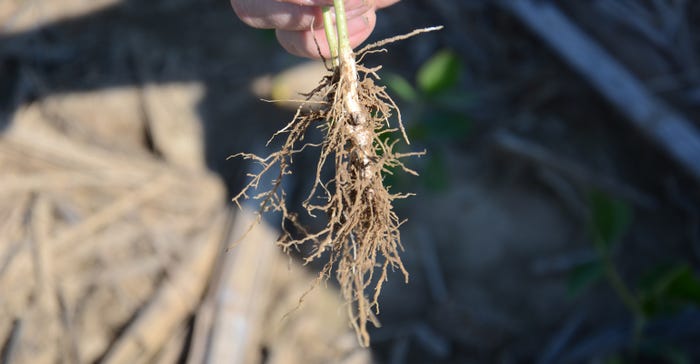
Three soybean plants came up together in a “brick of soil” with a straight side when Steve Gauck dug plants in the Soybean Watch ’20 field. The soil was a bit heavy at planting, but most of the field appeared to have been in good shape.
“The smooth, straight side of the brick of soil was against the furrow trench,” says Gauck, regional agronomy manager for Beck’s, based near Greensburg, Ind. Beck’s sponsors Soybean Watch ’20.
“It’s what we call sidewall soil compaction. It can happen even in no-till planting, and it’s created simply by the disk opener.”
Gauck found other clues to confirm that at least in this spot, the planter created sidewall soil compaction. He looked at roots of individual soybean plants. There were longer roots on the side of the root mass extending away from the planting trench compared to the side where roots encountered the compacted sidewall of the trench.
Possible consequences
Finding the soil compaction and noticing how it affected rooting is one thing. Determining how it will impact plants and final yield is a different story altogether, Gauck says. In this field, since the compaction was only in spots, Gauck doesn’t expect a big impact, if any. Soil compaction is more problematic if plants become stressed during the season. Drought stress is a classic example. In this case, the grower has irrigation available should drought stress develop during the reproductive phase.

UNEVEN ROOTING: Note that there are more roots on one side of this soybean plant than the other. The side with minimal roots was facing the planter furrow and was impacted by sidewall compaction.

The grower normally doesn’t irrigate soybeans during the vegetative phase for a couple of reasons. First, drier weather in his area usually sets up later in the season. Second, even if it does get a bit dry, irrigating when the crop is in the vegetative phase tends to produce leggy plants with more distance between nodes. He did irrigate this field after planting because there was a dry spell, and he wanted to ensure uniform emergence.
Even if irrigation weren’t available, there might not be an impact from sidewall soil compaction in soybeans, Gauck says. He relies on information provided by Gary Steinhardt, Purdue University Extension soils specialist, who has studied soil compaction for nearly 40 years.
“Even when we compacted plots on purpose in research trials, we typically didn’t see much, if any, yield difference in soybeans, even if there was stress during the season,” Steinhardt says. “We would see significant yield loss on compacted corn plots if it was a stressful year, but not on beans.
“They might look ragged during the year, but when harvest came around, there just wouldn’t be much, if any, yield difference. In years with ideal moisture, and not too much water, we didn’t even see a difference in corn.”
Steinhardt was dealing with deeper soil compaction, caused by running heavy equipment over plots on purpose. He also notes that sometimes soil compaction can be a cost of doing business. That was especially true in 2019, when planting delays led to planting even if conditions weren’t perfect.
About the Author(s)
You May Also Like




